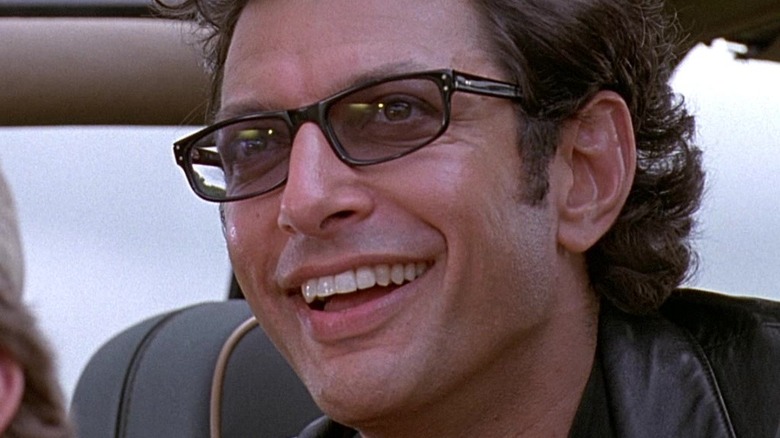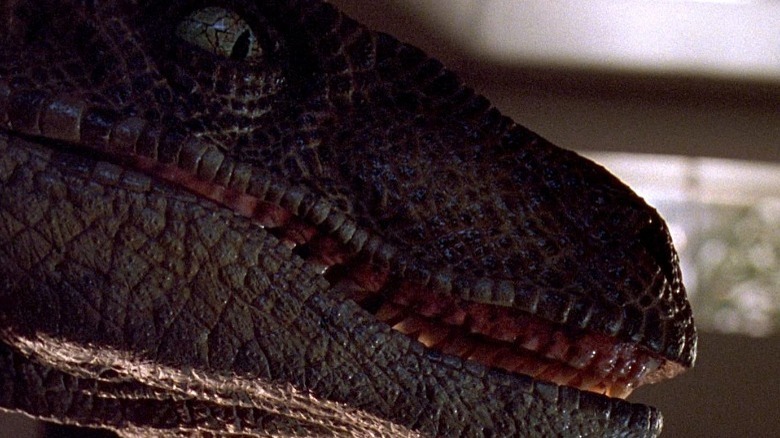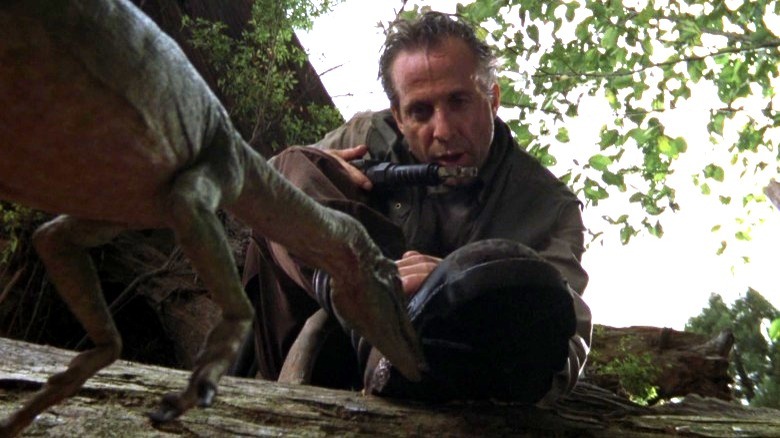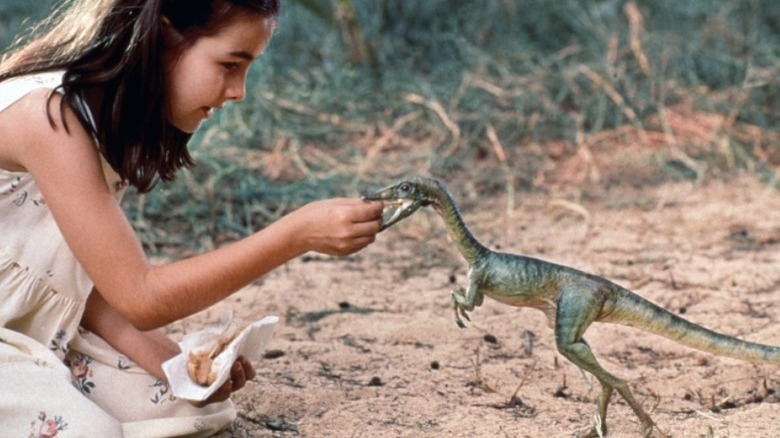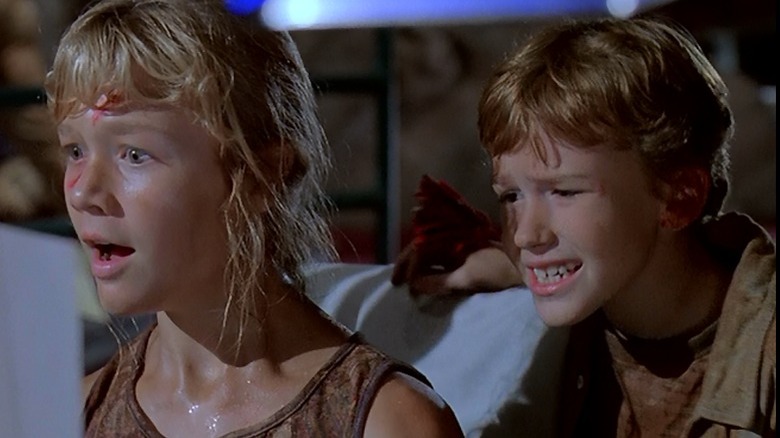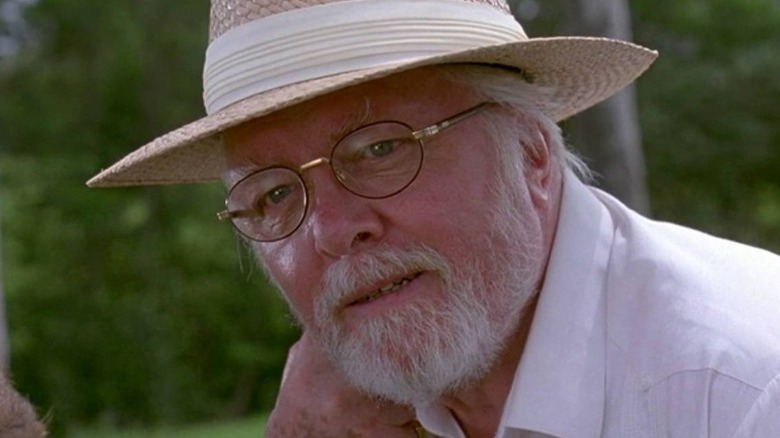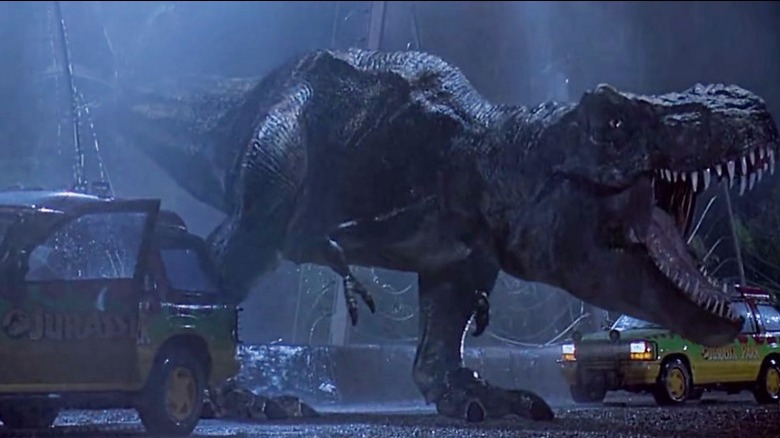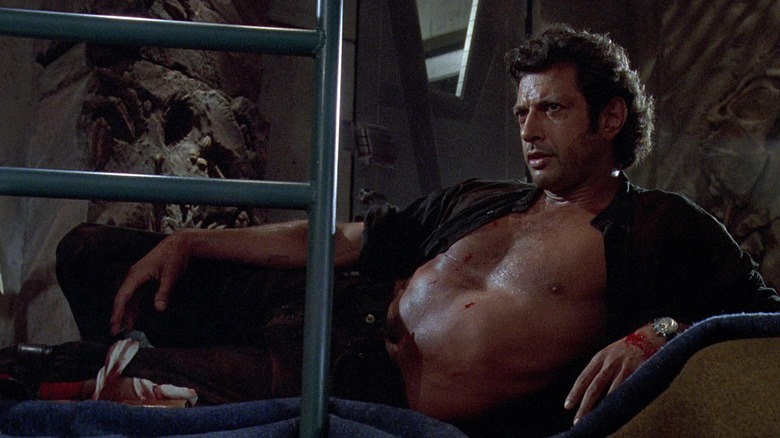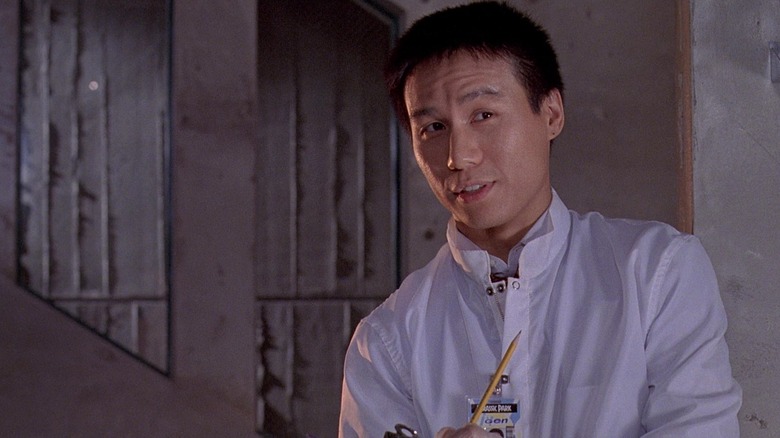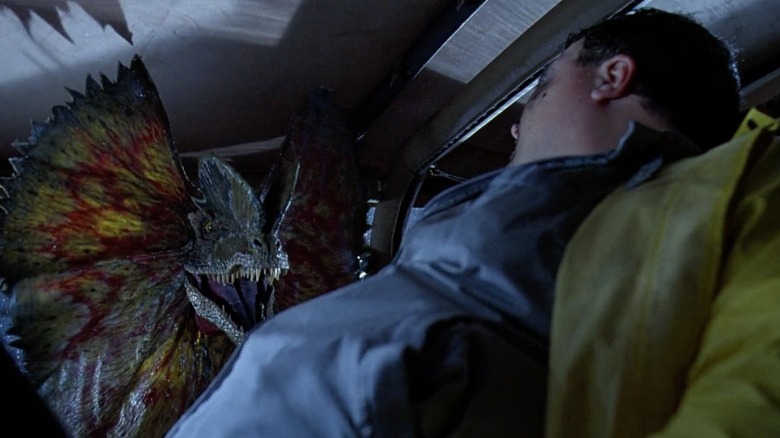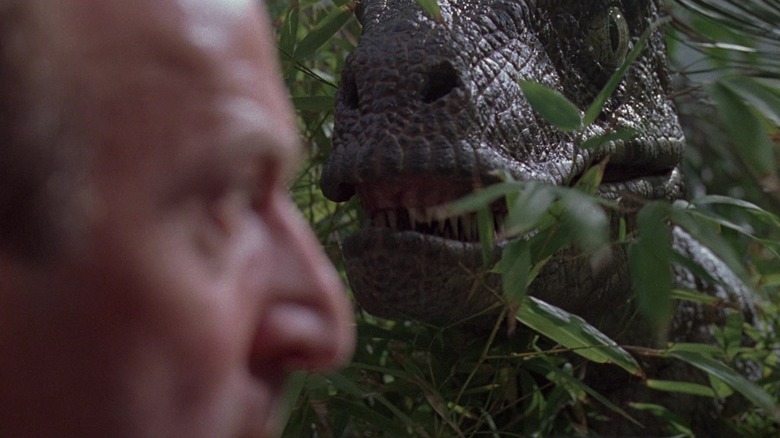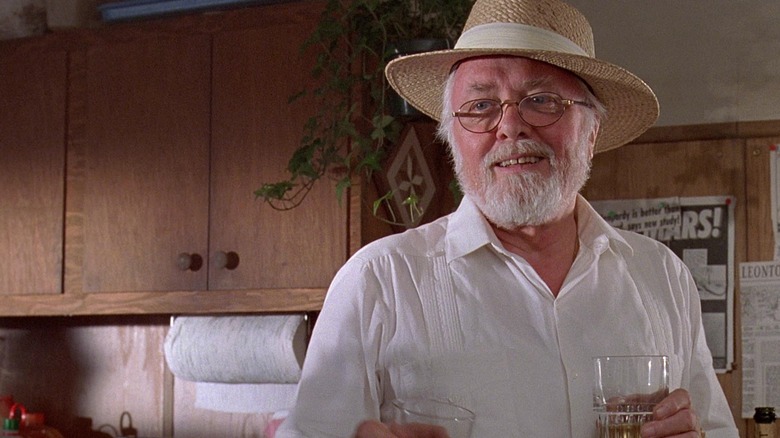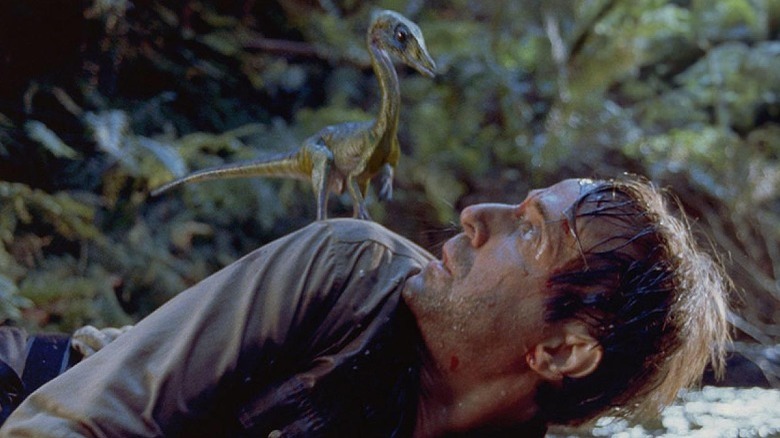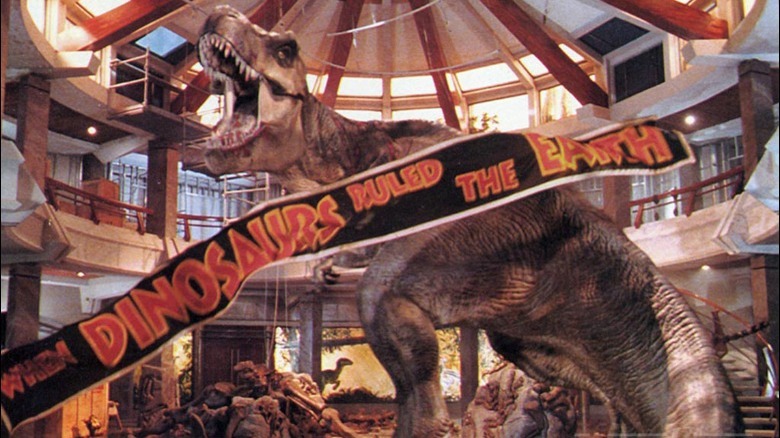All The Major Differences Between The Jurassic Park Novel And Film
Theme park monsters? Or genetically realized animals from a primal era? The "Jurassic Park" franchise has engaged in that very argument over its own plot for quite some time. Characters such as Dr. Alan Grant (Sam Neill) have even insinuated that the dinosaurs of John Hammond's (Richard Attenborough) island are nothing like the magnificent creatures that were alive 65 million years ago. Still, the idea of recreating dinosaurs with preserved DNA is fascinating. Would humans live in an awful state of terror, like in the films? It's anyone's guess. But if Michael Crichton, author of the novel, has anything to say about it, dinosaurs in our day would cause far more chaos than anything we've witnessed on screen.
Crichton's 1990 novel elevated the idea of genetic engineering in the public eye — a power the author warns shouldn't be used frivolously. While recreating dinosaurs might be a stretch, Crichton saw a world that was on the cusp of unlocking the potential of genetics research. His novel focuses on the idea that mankind shouldn't attempt to control nature, as it will surely backfire. Steven Spielberg's 1993 adaptation of the novel, co-written by Crichton and David Koepp, communicates the same message but is far more forgiving when it comes to punishing its characters for playing God. While the film honors the book's core plot, there are plenty of differences that set Crichton's original work apart from the film. Let's dive deep into some of the major differences between the film and the novel.
Both the novel and film kick off with a raptor attack
Steven Spielberg sets the stage for a thrilling world of dinosaurs with an introduction that establishes the film's tone. In the black of night, a caged raptor is being introduced to a fenced-in habitat on Isla Nublar. No sooner do we witness the vicious raptor disrupt the process than it begins chowing down on an unfortunate worker. Of course, none of the grisly violence is actually depicted on screen, but it is heavily implied, as the man screams for dear life while game warden Robert Muldoon (Bob Peck) attempts to help the poor fellow. The moment solidifies park owner and creator John Hammond's need for the endorsement of professionals like paleontologist Dr. Alan Grant and Dr. Ellie Sattler (Laura Dern) to ease the fears of the park's potential investors.
The book doesn't begin with a raptor attack. Instead, it focuses on the dark aftermath of such a mauling. The setting is actually an island off the coast of Costa Rica, where a patient with life-threatening injuries lands via helicopter. Those who accompanied the injured boy tell the medical professionals he suffered severe injuries during construction. But the doctor is no fool and can see that the bloody mess the hospital was just delivered is due to an animal attack. The boy dies from his wounds, but he manages to say that he was attacked by a raptor with his dying words.
Dinosaurs are already on the mainland in the novel
The film ultimately positions Dennis Nedry (Wayne Knight) as the primary reason for the park's failure. While John Hammond's ignorance and recklessness doomed the park from the start — and the use of frog DNA to reconstruct the gaps in the dino DNA sequence led to major genetic problems — it's ultimately Nedry's attempt at corporate espionage that sets the dinosaurs loose on the island. After shutting down the security systems, the T-Rex and Velociraptors have free reign across the park, which produces devastating results. The film heavily critiques Hammond's venture as one ruined by a lack of foresight. Hammond even attempts to say that he underestimated Nedry and that he'll ensure that problem doesn't happen next time. But Dr. Ellie Sattler adamantly insists that Nedry was merely one variable and that Hammond never had any control.
The book shows Hammond truly never had control from the get-go. There are reports of small dinosaurs (like the Compsognathus featured in the sequel "The Lost World: Jurassic Park") already on the mainland. In the novel, some Velociraptors stow away on a boat, so it's conceivable that the smaller ones could've more easily slipped by undetected. The dinosaurs, changing sexes and seeking out nutrients, even manage to circumvent the park's security protocol for managing their populations. With no knowledge of how these creatures would behave once raised from birth, it's easy to see how Hammond's security is so ill-equipped and under-prepared.
The Jurassic Park novel opens with a girl attacked by Compies
While the filmmakers use the raptor attack on the InGen worker at the beginning of the film to justify a need for increased security and the endorsements of professionals to appease investors, the novel sees John Hammond and his cronies attempting to cover up the fact that a boy was killed by a raptor. The book underlines the danger of Hammond's dinosaurs and Hammond's own lack of control when the affluent Bowman family experiences a dinosaur attack while on holiday in Costa Rica. Their young daughter is assaulted by several Compsognathus but survives. The original film never depicts this scenario.
However, "The Lost World: Jurassic Park" recreates this scene from the original novel as the Bowman parks its fancy yacht at Site B, Isla Sorna. This scene is the catalyst that enables Hammond's nephew, Peter Ludlow (Arliss Howard), to take control of InGen after the board ousts Hammond over the incident. Ludlow goes on to hunt and capture the dinos populating Isla Sorna in an effort to bring Hammond's business venture stateside. As Ian Malcolm (Jeff Goldblum) later states, it's a truly "worst idea in the long, sad history of bad ideas."
Tim and Lex are much different in the book
Nothing ramps up tension and terror like putting children in danger. Lex (Ariana Richards) and Tim (Joseph Mazzello), John Hammond's grandchildren, are the lucky youngsters who get to go on the thrill ride of a lifetime. And let's be honest, they'll probably need therapy for the rest of their lives. While the pair manages to survive the hellish dinosaur onslaught at their grandfather's theme park, they don't walk away entirely unscathed. In the film, Tim takes a lightning rod of electricity after being zapped by the fences on the perimeter of an enclosure.
In the film, Tim is the younger of the two and a bit of a dinosaur know-it-all. His big sister, Lex, fancies herself a computer whiz. Her brother teases her about her nerdy interests, but Lex's hacking wizardry aids the survivors in the climactic ending as they flee raptors on the hunt.
In the novel, Tim is actually older than Lex. He's also the nerdy one of the pair. Effectively, their characteristics were swapped in the film. Lex is often snide and snarky in the novel and proves to be rather irritating. She's almost as unlikeable as her greedy grandfather and certainly fits the bill of a spoiled child.
John Hammond is the villain of Jurassic Park
The driving force behind Jurassic Park is John Hammond. Through his wealth and his company's resources, dinosaurs once again walk the Earth. It's a feat so remarkable that it's easy to lose sight of the dangers that come with it. The film positions Hammond as a true-blue fan of his creations. He never had any intentions beyond bringing these relics of the past to life for the world to enjoy. Hammond is simply naive and lost in his own sense of wonder. He never set out to be famous or expand his own wealth — a point that is proven when he tells his lawyer, Donald Gennaro, that he doesn't want the park to cater to the rich. He wants everyone to be able to enjoy the animals. However, after the park descends into chaos, Hammond realizes his ambitions were shortsighted and does all he can to help his guests survive.
Michael Crichton's version of the character is irredeemably hell-bent on his own capitalistic desires. Furthermore, he consistently ignores the danger and instability of the park. The animals are already out of control before Grant or anyone else sets foot on the island. Additionally, his employees' efforts to keep events like the opening raptor attack quiet demonstrate how slimy and careless Hammond truly is. He never learns from his mistakes, even after the dinosaurs break free and wreak havoc. For all intents and purposes, Hammond is a villainous figure in the book.
The book pits Ed Regis against a juvenile T-Rex
Perhaps the most harrowing and memorable scene in the entire movie is the moment the T-Rex breaks out of the confines of its paddock and terrorizes the tourists in their stationary vehicles. Donald Gennaro (Martin Ferrero), John Hammond's lawyer, bolts the moment he sees the Tyrannosaur, leaving the children, Lex and Tim, all by themselves. Of course, that moment becomes the cowardly lawyer's undoing when the T-Rex crashes through his bathroom stall hiding place to find him sitting on the commode. He then becomes dinner for the beast.
In the novel, Gennaro actually survives the events that occur at Jurassic Park. A grisly death at the maw of a Tyrannosaur is reserved for another fellow by the name of Ed Regis, who is absent from the film. He is Hammond's public relations manager for the park. During the T-Rex breakout, the adult Tyrannosaur is accompanied by a juvenile Rex. (The juvenile T-Rex concept would be used in a later film, "The Lost World: Jurassic Park.") The animal is still large in stature and very feisty. The juvenile Rex munches on Ed, who tries to save the children, only leaving his leg behind to be found by Robert Muldoon and others much later. Can you imagine the irony of that headline? "Jurassic Park PR manager eaten by dinosaurs."
The Jurassic Park novel seemingly kills off Ian Malcolm
Despite Ian Malcolm's prophesies of a doomed park, he still sets foot in the danger zone. While no one could have ever expected Dennis Nedry to hasten the demise of the park, Malcolm still calls it like he sees it. He plainly tells John Hammond that he and his scientists wield genetic power like "a kid that's found his dad's gun." Ian learns firsthand that his theories of chaos are all too relevant to Jurassic Park. Anything that can go wrong, does go wrong. After attempting to lure the T-Rex away from the children, the beast launches Ian into the air with its massive head, injuring the chaotician. For the remainder of the film, Ian is incapacitated, the voice of reason to help advise the survivors.
In the novel, a similar turn of events occurs. However, the animal actually picks Ian up in its jaws, shakes him, and throws him to the ground before being distracted and moving on. Ian is later recovered by Donald Gennaro and Robert Muldoon at the site of the T-Rex attack. However, his injuries are far more severe than his cinematic counterpart. Throughout the remainder of the book, he lectures the survivors on his ideas of a volatile world. He also attempts to help offer advice to aid in the group's survival. Unfortunately, however, he seemingly succumbs to his injuries and is declared dead, even though Michael Crichton decided to retcon this for the sequel.
Dr. Henry Wu is a major player in the novel
The film grants B.D. Wong's Henry Wu a brief moment in the spotlight. He walks the visitors through a baby raptor hatching right before their very eyes and explains to the crew how the geneticists have put controls in place to manage the dinosaurs. Henry explains that all of the animals are female to keep them from breeding and that they are lysine-deficient, forcing them to obtain regular supplements from the park staff or else they'll die. Of course, the "Jurassic World" trilogy sees Wu's character return in a more nefarious role as he continues his work in genetics research at the peril of those around him, creating such monstrosities as the Indominus Rex and the Indoraptor.
In the novel, Wu is more prevalent in the narrative and is John Hammond's chief geneticist, who in effect, does the same level of work we see Wu doing in the "Jurassic World" film. He isn't just one in a team of scientists overseeing the creation of new baby dinosaurs. He's the guy who masterminds it all. As such, he's positioned as a villainous character much like Hammond. The two are completely blinded by their own success and ambition. Whereas Wu leaves the island in the film before the storm rolls in and chaos ensues, he sticks around in the book, long enough to meet a grisly fate as Velociraptors tear him apart.
The film is much less gruesome than the novel
The world of Steven Spielberg's "Jurassic Park" is a harrowing one rife with danger and a high probability of physical maiming or death. A handful of characters learn that reality all too well, including Dennis Nedry, Robert Muldoon, Ray Arnold (Samuel L. Jackson), and Donald Gennaro. All of these characters fall prey to the razor-sharp teeth of carnivorous dinosaurs. Despite a substantial amount of death, "Jurassic Park" maintained a PG-13 rating, using careful framing and editing to make almost all of these pretty brutal deaths mostly bloodless (except Ray's severed arm).
Michael Crichton's book doesn't spare the gory details. Nedry's demise is, perhaps, the most gruesome. Though he is still killed by a Dilophosaurus, the creature gets surgical (we'll spare you the details) before clamping its jaws down on the programmer's dome and raising him in the air. Apparently, this adult Dilophosaurus is a bit larger than the one we see in the film. You can imagine, then, that the vicious raptor attacks, particularly on Dr. Henry Wu, and the young Tyrannosaur eviscerating poor Ed Regis are described in a similar bloody fashion. If Crichton's novel were adapted perfectly, "Jurassic Park" would have been an R-rated film. For the time, that was certainly not feasible or practical from a money-making perspective.
The dinosaurs attempt an island escape in the novel
The "Jurassic Park" trilogy — and later, the "Jurassic World" films — ponders the very thought of humankind and dinosaurs existing side by side. It's a wild prospect and is ultimately an unnatural one, given that dinosaurs were rendered extinct via meteor millions of years ago. Still, one can't help but wonder: What would our world be like if dinosaurs still roamed the Earth? "Jurassic World Dominion" is the series' closest look at that idea. However, dinosaurs never make it off the shores of Isla Nublar in the original film.
In the book, however, dinosaurs are far craftier than their human creators could've suspected. Reports of small dinosaur-like creatures on the mainland indicate that the animals have already escaped the island. In fact, the book ends on an ominous note teasing that very fact. However, the dinosaur behaviors beckon them to migrate. In the novel, Velociraptors use their smarts to attempt migration by boarding a vessel leaving Isla Nublar. Dr. Alan Grant sees this, and the revelation is the chief reason he has to return to the visitor center with Lex and Tim — to get the boat to turn around before it's too late. It's an interesting plot point that never made it into the film, though the T-Rex escape aboard the ship in the sequel would emulate this.
Hammond dies in the book
Despite John Hammond leading some unsuspecting dinosaur experts into an unmitigated blood bath, Hammond survives the ordeal in Steven Spielberg's adaptation. After all, Hammond is a very different type of character from his novel counterpart and ultimately realizes his follies, renounces the park, and becomes a beloved character. Despite the failings of the park, there are likely countless people, including many of us fans, who share Hammond's sense of wonder and drive for discovery. His relatability and redemption ultimately give him the plot armor needed to survive the film.
The Hammond of Crichton's novel, on the other hand, is killed by his own ambition. Aside from Ian Malcolm, the deaths that result in the novel are employees of InGen and managers of the park in some capacity. It's an ironic twist of fate seeing those who enabled Hammond's wild ideas to go unchecked getting picked off one by one. Even amid the deaths of several employees, Hammond still toys with ideas for a bigger, better park. As he strolls through the jungle after the chaos has ended, he's midway through such a daydream when he's startled by a Tyrannosaurus Rex roaring in the distance. (It turns out to be a recording, played by Tim and Lex.) Hammond stumbles and falls into a pack of Compies, which proceed to bite and devour him.
A Compy's bite is toxic in the novel
One significant difference between the novel and film is that not even a single Compsognathus (or Compy for short) is present in the original movie. Steven Spielberg and crew save this little rascal for the sequel, "The Lost World: Jurassic Park." In the second film, the animals are depicted as tiny pack hunters that overwhelm prey larger than themselves by the sheer strength of their numbers. Having several tiny sharp jaws clamping down all over your body is likely enough to subdue any living creature. The sequel film's Dieter Stark (Peter Stormare) receives this painful death that ultimately mirrors John Hammond's own demise in the original novel, as Compies swarm and assault the lost man.
There is one primary difference between the Compies depicted in the novel versus their first on-screen appearance in the sequel film "The Lost World." While the animals do, in fact, swarm their prey in the novel, their bite is also laced with a toxin that forces its prey into a weary state of paralysis. This enables the animals to eat their prey without fighting the creature. This makes Hammond's death at the end of the novel all the more horrifying, as he's still alive when the little animals begin to dig in. The film counterparts might retain this trait, but nobody in "The Lost World" or "Jurassic Park III" explains this aspect of a Compy's bite.
The Costa Rican government bombs Jurassic Park in the novel
Not much is spoken of Isla Nublar in the succeeding films until "Jurassic World." The dinosaurs clearly roam free for a time until InGen and Masrani Global Corporation, led by Simon Masrani (Irrfan Khan), move in to overhaul the place as Jurassic World decades later (though the franchise does revisit the island in the Netflix animated series "Jurassic World Camp Cretaceous"). For a time, though, dinosaurs likely enjoyed the tattered remains of Jurassic Park freely and without human intrusion. Of course, one must wonder how the world would view creatures who are suddenly no longer extinct. Once the word got out, there'd likely be a swift decision made by governing bodies, especially since the park and its carnivorous inhabitants resulted in multiple deaths and casualties.
In the novel, that very thing occurs. Without John Hammond around to defend his assets, the Costa Rican government intervenes. After all, they're the ones who are seeing the results of Hammond's experiment-gone-wrong as some dinosaurs begin making their way to the mainland. The Costa Rican government orders the bombing and napalming of the entire island, eradicating dinosaurs once again from the face of the Earth... mostly. Of course, we know this second extinction isn't really an extinction at all when the sequel novel reveals that Hammond had a second island where the dinosaurs were mostly just bred and studied. Life finds a way.
